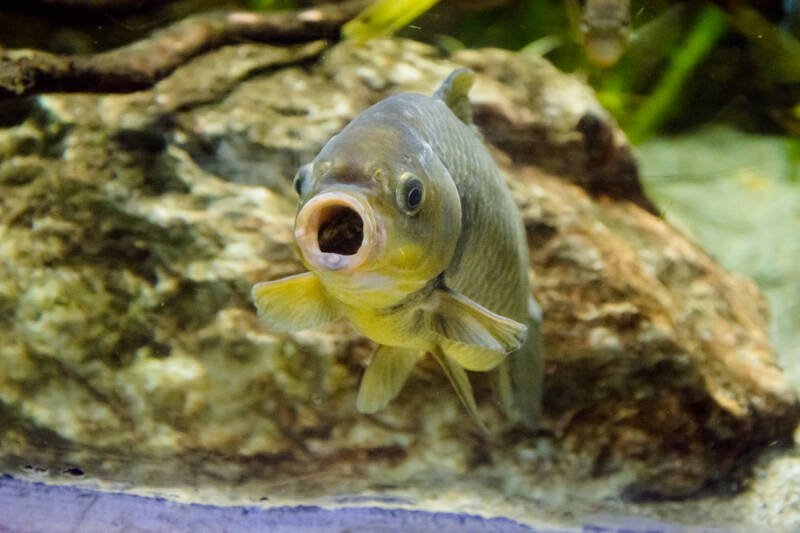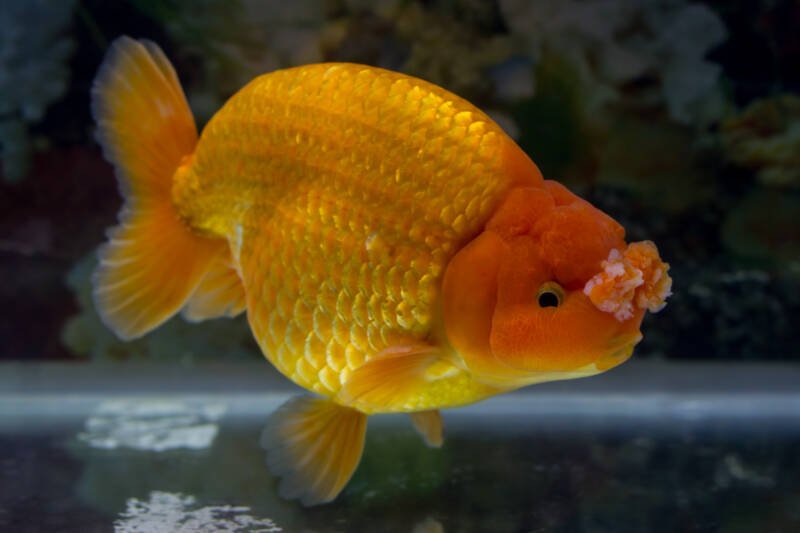When many of us think of goldfish, we think of those cute, little fish swimming joyfully around in modestly sized bowls.
You may be surprised to learn that this species, called Carassius auratus in scientific terms, can grow surprisingly large.
After all, they are related to the common carp, which can reach up to two feet (61 cm) in length.

While myths abound about how these creatures will only grow to fit the size of their tank, this cannot be further from the truth.
You can and should expect your goldfish to reach a decent size.
Exactly how big can you expect your goldfish to grow? How quickly will they reach this size? Keep reading for answers to these questions and more.
In this article
How Big Will a Goldfish Get?
A quick internet search yields dozens of links to stories of massive goldfish, some raised in captivity, others caught in natural ponds and lakes. Are they all true?
Yes and no. Some of these “wild goldfish” are properly identified, measured, and weighed. Others may be a case of mistaken identity.
There are a couple of common species that have similar coloration and shape as the goldfish and can reach massive sizes.

Catching one of these species could lead someone to believe they have hooked a giant goldfish, when in reality, it may be a Prussian carp or koi.
These fish, especially the koi, can reach up to 36 inches (90 cm) in length.

The Guinness Book of Records lists the world’s largest goldfish as reaching a whopping 18.7 inches (47.4 cm) in length.
The fish lived in Hapert, Netherlands, and was owned by Joris Gijsbers.
Do All Goldfish Grow That Large?
The ultimate size they can reach depends heavily on the goldfish species.
There are over 50 different recognized goldfish “forms” in the United States. Travel to China, and that number is six times higher!
These forms include differences in body shape, tail and fin configuration, eye type, color, and the presence (or not) of a wen.
With that much variation, it is challenging to state a standard “size” for a goldfish; however, they fall into two general categories.
Streamlined Body

A common goldfish, with its streamlined body and single, forked tail, can reach up to 12 inches (30.5 cm) in length as an adult.
The flowing finned comet goldfish and multicolored Shubunkin each top that length at 14 inches (35.6 cm).
Egg-Shaped Body

Fancy goldfish have traits such as modified, egg-shaped bodies that make it harder to attain the size of their sleeker brethren.
For example, you will see species like the fantail or ryukin reach a shorter overall length between eight to nine inches (20 to 23 cm).
Other unique variations, such as the oranda goldfish, with their impressive wen growths, will still reach a sizable 12 inches (30.5 cm).
Research the type of goldfish you are considering to determine their ultimate size.
If you purchase from a reputable breeder, you are more likely to get a better estimate of their ultimate size versus simply selecting a fish at your local store.
How Do These Fish Get So Big?
Goldfish growth comes down to two things: environment and diet.
Environment
The environment for your goldfish includes not only the size of the tank or outdoor pond but the water quality.
Fish that live in clean water and an appropriately sized tank will thrive over and grow bigger than those kept in sub-optimal conditions.
Water Quality
Goldfish live and grow best in clean water with a decent oxygen content. Although they are hardy enough to tolerate poor conditions and extremes, these will stress your fish and can lead to stunted growth.
Make sure that your water is well filtered and tested regularly to keep ammonia, nitrite, and nitrate levels within tolerance ranges and steady.
Change out around 30 percent of the water weekly to keep it in the best shape. Strive to keep the pH between 6.0 and 8.0 and the hardness from 5 to 20 dGH.
For optimum growth rates, the water temperature should be between 68 to 74°F (20 to 23°C). This will encourage healthy metabolism and growth for your fish.
Clean your tank regularly to account for all the waste goldfish produce. Invest in a gravel vacuum and regularly clean your filters.
Tank Size

Tank size is also critically important to proper goldfish growth. You know that this fish can grow up to 14 inches in length as an adult.
Keeping them in too small of a tank is unhealthy and cruel as they need adequate space to grow in a healthy way.
A tank size of at least 30 gallons (114 l) for a single fish (raise that amount by 10 gallons (38 l) for each additional fish you keep) will work while they are young.
However, they will eventually outgrow this size. Depending on the breed you have, you may need up to 75 gallons (284 l) for a single adult fish.
Planning for this tank size up front will save you from having to rehome your fish once they get too large.
Remember that sleek-bodied goldfish are active swimmers. Select a tank that is wider than tall to give them extra room to accommodate their activity levels.
Diet
What you feed your goldfish matters, too. Their diet should be varied – do not simply feed them flakes and expect them to grow large.
A well-rounded diet will include the occasional treat of live, frozen, or freeze-dried meaty foods, such as bloodworms, brine shrimp, and daphnia. Remember to pre-soak any freeze-dried foods before feeding them to your fish.
Do not forget that these omnivores need some veggies in the rotation.
Shelled peas are an excellent choice. Not only do goldfish love them, but they help to prevent constipation, which is a common ailment for this species.
They will also accept other vegetables, such as zucchini, just be sure to blanch them first.
Spread the meals out during the day. Give them two to three small servings per day, allowing time for them to digest in between meals.
Provide only as much as they can finish in a minute or so as leftover food can quickly turn your water quality poor or result in potentially deadly spikes in ammonia.
How Fast Do Goldfish Grow?

The average growth rate for goldfish is around a half inch to an inch per year. This can vary depending on the environment in which the goldfish lives and the food it receives.
Fish kept in outdoor ponds will experience bursts of growth in the warmer months, followed by a slowdown during the winter when they become dormant.
When the water temperature gets below 60°F (15.5°C), goldfish will slow down their metabolism and remain fairly still near the bottom of the pond.
These dormant fish will not need to be fed (although you should plan to feed them slightly more in the months prior to hibernation).
To ensure your fish survive the winter, aerate the water and do not allow the surface to completely freeze.
The goldfish in ponds will resume growing come spring. Goldfish kept indoors at steady temperatures will experience a steady growth rate.
Closing Thoughts
If you are thinking that the tiny, two-inch-long fish you purchased at the local pet store is going to become a giant goldfish, you may be right. With proper care and a larger tank, goldfish can reach impressive sizes.
Releasing this species into natural waterways simply because they have grown too large is never an option.
Fancy goldfish would have a difficult time surviving due to their limited swimming ability.
However, the hardier strains can thrive and are considered an invasive species. These fish form large populations that outcompete local species for resources, increase water turbidity and impact plant growth, and in some cases, carry disease that can wipe out other fish.
Plan for your goldfish’s size early on and give them the care they need to grow best.
Let’s hear from our readers! How big have your goldfish grown to be?